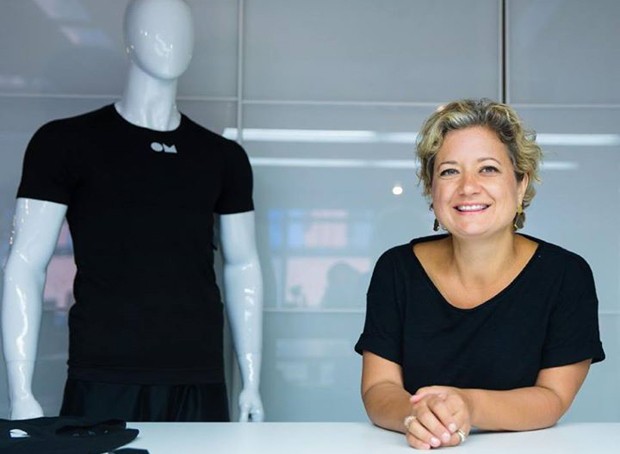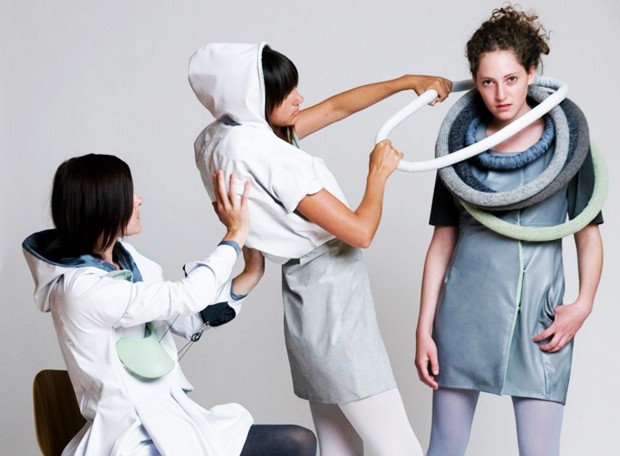A next-generation 'second skin'
 Joanna Berzowska from Concordia's XS Labs: “How can we embed computation in textiles rather than attach devices to our bodies?” | Photo courtesy of Contact MTL
Joanna Berzowska from Concordia's XS Labs: “How can we embed computation in textiles rather than attach devices to our bodies?” | Photo courtesy of Contact MTL
One of the distinguishing features of Concordia’s new research centre Milieux Institute for Arts, Culture and Technology is its interdisciplinary nature. Here, Sandra Huber, a student researcher in the Media History cluster, sits down with Joanna Berzowska from the Textiles and Materiality cluster. Berzowska is research director of XS Labs.
Wearable tech meets disruptive designs
How does design account for the smelly, dirty, provocative elements of the body?
Joanna Berzowska, associate professor in Concordia's Department of Design and Computation Arts, knows. As the leader of XS Labs, she’s been exploring this uncomfortable question for years.
What happens when wearable technology research focuses only on “improving” the body rather than existing in imperfection? Most of Berzowska’s work, such as the Skorpions dresses, is meant to cause actual discomfort.
Her garments draw the wearer’s attention to a state of constant change, constant alive-ness, and all the messiness that this entails.
Berzowska’s area of expertise exists somewhere between industrial patents and intimate clothing. Before founding XS Labs, she studied and worked at the MIT Media Lab, where she earned her master of science, and co-founded International Fashion Machines with Maggie Orth.
At MIT, a visible gender divide determined how researchers navigated this area. Male researchers tackled wearables. Female researchers were more invested in embodied interaction. “They were interested in textiles and the surface of the skin,” she says, “and what I now call beyond-the-wrist interaction."
Beyond the wrist?
According to Berzowska, this is the space that male-dominated wearable research fails to see, because it focuses on head-mounted displays, such as Google Glass, or on creating protective exoskeletons.
But what about the rest of the body? What about the sweat, the tears, the meat and bones that don’t fit easily into an engineering research model? Berzowska wants to know.
 The XS Labs project, Captain Electric and Battery Boy. | Image courtesy of XS Labs
The XS Labs project, Captain Electric and Battery Boy. | Image courtesy of XS Labs
The question is, how can we embed computation in textiles rather than attach devices to our bodies? Her answer involves looking at “simple kinds of interactions or simple kinds of functionality that are more interested perhaps in well-being or pleasure or just everyday experience or communication."
That answer resonates with the name of Berzowska’s research space, XS Labs, which stands for “Extra Soft.” In pointing to that space beyond the wrist, the lab’s mission is to trouble the distinction between “hard science” and the “soft."
XS Labs is part of the Textiles and Materiality cluster at Concordia’s new Milieux Institute for Art, Culture and Technology. The cluster has an across-the-board female helm, including Barbara Layne of Studio subTela, and Kelly Thompson, whose studio boasts a full-size jacquard loom.
Though “soft” and intimate, Berzowska’s work does not exist in the realm of whimsy or art-for-art’s sake. In fact, Berzowska does not see herself as an artist or any sort of solo creator, but as part of a team of designers.
“For me, design fits a lot better into this research model where we have multiple authors for each project,” she says.
“It’s almost like thinking of the research work as a theatre performance, or a play, or an orchestra … design is perhaps a little bit more concerned with the tools, the materials, the processes, rather than the final moment of showing the piece.”
Berzowska’s garments each act as a kind of personal theatre, full of possibilities for potential performance. The Reclaim dress is fitted with silicone balloons that can be inflated should the wearer find herself needing more personal space. The Acouphène blazer is embroidered with touch-activated soft speakers that create a three-dimensional sonic environment around the wearer.
There is also a “harder” aspect to Berzowska’s work. “I’m writing a lot of patents right now with OMsignal,” she says. “And those aren’t artefacts. That’s intellectual property (IP) that has a high monetary value.”
The level of intimacy Berzowska engages with in the creation of her wearables may not easily be equated with something like a patent. But new intellectual properties are one of her lab’s central design products.
A patent is never far from the body, because a patent is a kind of memory. It’s the memory of a practice, and, as Berzowska says, her practice always comes down to the practical, the everyday. Even the way she uses the word “memory” has to do with “memories of our own experiences, the very kind of concrete experiences, meaning the sweat, the hairs, the food stains, the coffee stains.”
“I remember working with somebody at the Institute of Communication Agencies (ICA) conference in Vancouver,” she says at the end of our coffee. “It was like this brainstorming thing we were doing — and one of the ideas was a shoe that grows out of your own foot fungus. There’s a lot of potential in those kinds of things."
Find out more about the Milieux Institute for Arts, Culture and Technology’s Media History and Textiles and Materiality clusters.


